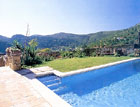Spain: Still the Best Investment
With a constant rate of growth in the number of foreign residents looking to buy second homes, Spain, and particularly Mallorca are wise choices for investment, agree estate agents in Britain.


In recent years, the Spanish property market has been second only to that of the UK in terms of overall levels of activity and house-price inflation. According to a recent report by the Royal Institute of Chartered Surveyors (RICS), the increase in the level of house prices last year was greater in Britain and Spain than elsewhere in Europe. Spanish house prices rose by 12% on average, with property prices in key areas of the UK soaring by up to 25%. The two markets are not entirely unrelated, of course, because the strength of the UK economy in recent years, allied to historically low interest rates, has boosted not only the UK housing market, but also that of coastal areas of Spain, such as Andalucia, Murcia and the Balearic islands of Mallorca, Minorca and Ibiza. In mainland Spain, the highest levels of house-price inflation were recorded in Madrid, Murcia, Andalucia and Castilla-La Mancha. The Balearics are now the fourth most expensive region of Spain in which to buy. A recent report by Spain's national statistics institute reveals the extent to which the second-homes boom has been driven by an influx of foreign residents. According to the census office, in 1991 there were 353,367 foreign residents in Spain; by the end of 2001, that figure rose to 1,572,017. In the Balearics, the addition of 95,000 new second homes to the regional housing stock in the same decade represented one of the biggest property booms to take place anywhere in Spain. It was a boom which, incidentally, brought not only a sharp rise in house prices, but the imposition by the regional government of an indefinite halt on new development in the region. As a result of that, demand may well outstrip supply in the not-too-distant future. According to leading industry analysts, the predicted slow-down in the Spanish property market is likely to have only a minimal effect on the country's sunshine-homes market in the next few years. About 70% of Spain's 'residential tourism' centres on Andalucia and Valencia, notably the Costa del Sol and Marbella. In fact, many observers maintain that the only factor preventing even greater growth in the area is that, unlike other autonomous regions of Spain, Andalucia does not offer tax incentives to those wishing to buy second homes. Nueva Andalucia is essentially the conurbation of Marbella, bordered to the south by the international marina of Puerto Banus. For developers and buyers alike, the international golf market continues to play a dominant strategic role in this area - hence its nickname of 'Golf Valley'. The strong pound of recent years has also led to a revival of interest in the Balearics on the part of UK buyers, and despite the weakening of sterling's position vis-a-vis the euro, Michael Cunnington of Kuhn & Partner in Mallorca - the island's biggest chain of international estate agents - predicts continued growth. 'In all my years dealing with Mallorca, I have never known prices here to fall, although they may plâteau from time to time,' Mr Cunnington says. The prosperous and endearing island of Mallorca has made strenuous efforts to upgrade its international image in recent years. The marble halls of Palma's vast international airport already handlesome 16 million visitors a year. The island is surrounded by some of the finest sailing waters in Europe, and waterside sites always command a premium.
Sign up for the Country Life Newsletter
Exquisite houses, the beauty of Nature, and how to get the most from your life, straight to your inbox.
Country Life is unlike any other magazine: the only glossy weekly on the newsstand and the only magazine that has been guest-edited by HRH The King not once, but twice. It is a celebration of modern rural life and all its diverse joys and pleasures — that was first published in Queen Victoria's Diamond Jubilee year. Our eclectic mixture of witty and informative content — from the most up-to-date property news and commentary and a coveted glimpse inside some of the UK's best houses and gardens, to gardening, the arts and interior design, written by experts in their field — still cannot be found in print or online, anywhere else.
-
 Six rural properties with space, charm and endless views, as seen in Country Life
Six rural properties with space, charm and endless views, as seen in Country LifeWe take a look at some of the best houses to come to the market via Country Life in the past week.
By Toby Keel
-
 Exploring the countryside is essential for our wellbeing, but Right to Roam is going backwards
Exploring the countryside is essential for our wellbeing, but Right to Roam is going backwardsCampaigners in England often point to Scotland as an example of how brilliantly Right to Roam works, but it's not all it's cracked up to be, says Patrick Galbraith.
By Patrick Galbraith